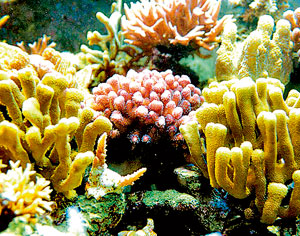The tsunami that struck Japan on Friday brought back memories of the tsunami of 2004 that devastated many parts of Sri Lanka. At the time, the steady destruction of coral reefs around the country was believed to have aggravated the impact of the disaster. The theory was confirmed by Sri Lankan scientist, Harindra Fernando, who was in Sri Lanka recently.
“We created a model of the 2004 Indian Ocean tsunami wave in the lab and tested the effects of damage caused by different wave heights, with and without underwater barriers resembling corals,” said Professor Harindra Fernando of the University of Notre Dame, Illinois, US.
 |
| Anemones corals |
Prof. Fernando was in Sri Lanka in January to initiate talks for joint research with India on the Indian Ocean monsoons. He was also on a team of international scientists who visited Sri Lanka immediately after the tsunami in 2004.
The team collected data, including the height and reach of the tsunami waves in different parts of the country. At Peraliya, the tsunami wave was about 30 feet, and surged inland for more than a mile; at Hikkaduwa, the wave came ashore at a height of about nine feet, and barely grazed the beach. Such dramatic variations prompted the team to investigate the underwater conditions at these spots.
Divers were hired to asses the extent of damage to underwater coral reefs. They came back with photographs that revealed greatly reduced coral cover in areas where the tsunami had caused the most destruction.
Back at his lab in the US, Prof. Fernando, a specialist in fluid dynamics, and his team used a wave tank to run waves at different speeds and heights, and measured the results with and without underwater barriers.
“We made tsunami models with simulated coral reefs,” Prof. Fernando told the Sunday Times. “What we saw was that where there was no coral, the surging water increased by a factor of three or more. Put simply, if you take resistance off from a flow, it moves faster.”
In 2005, a year after the tsunami, Prof. Fernando and his research team demonstrated scientifically that there was a direct link between coral mining and the level of tsunami devastation. Despite the finding, coral mining continues in many parts of Sri Lanka.
“We do not seem to learn from our lessons, even after a deadly disaster,” says environmentalist Jagath Gunawardane. Coral mining goes on unchecked, especially in the East and North. In the southern areas, most of the coral reefs have already been destroyed.
An environment law specialist, Mr. Gunawardane said coral mining is illegal, and that the Police, the Department of Coast Conservation, and the Department of Wildlife Conservation were authorised to enforce the law, whenever necessary |


